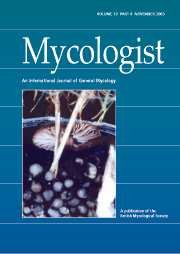Crossref Citations
This article has been cited by the following publications. This list is generated based on data provided by
Crossref.
Talabardon, Mylene
and
Yang, Shang‐Tian
2005.
Production of GFP and Glucoamylase by Recombinant Aspergillusniger: Effects of Fermentation Conditions on Fungal Morphology and Protein Secretion.
Biotechnology Progress,
Vol. 21,
Issue. 5,
p.
1389.
Wang, Liping
Ridgway, Darin
Gu, Tingyue
and
Moo-Young, Murray
2005.
Bioprocessing strategies to improve heterologous protein production in filamentous fungal fermentations.
Biotechnology Advances,
Vol. 23,
Issue. 2,
p.
115.
Dienes, Dóra
Börjesson, Johan
Hägglund, Per
Tjerneld, Folke
Lidén, Gunnar
Réczey, Kati
and
Stålbrand, Henrik
2007.
Identification of a trypsin-like serine protease from Trichoderma reesei QM9414.
Enzyme and Microbial Technology,
Vol. 40,
Issue. 5,
p.
1087.
Braaksma, Machtelt
Smilde, Age K.
van der Werf, Mariët J.
and
Punt, Peter J.
2009.
The effect of environmental conditions on extracellular protease activity in controlled fermentations of Aspergillus niger.
Microbiology,
Vol. 155,
Issue. 10,
p.
3430.
Singhania, Reeta Rani
Sukumaran, Rajeev K.
Patel, Anil Kumar
Larroche, Christian
and
Pandey, Ashok
2010.
Advancement and comparative profiles in the production technologies using solid-state and submerged fermentation for microbial cellulases.
Enzyme and Microbial Technology,
Vol. 46,
Issue. 7,
p.
541.
Rani Singhania, Reeta
2011.
Biofuels.
p.
177.
Brown, T. A.
2011.
Gentechnologie für Einsteiger.
p.
205.
Rozhkova, A. M.
Sereda, A. S.
Tsurikova, N. V.
Nurtaeva, A. K.
Semenova, M. V.
Rimareva, L. V.
Rubtsova, E. A.
Zorov, I. N.
Sinitsyna, O. A.
and
Sinitsyn, A. P.
2011.
Creation of a heterologous gene expression system on the basis of Aspergillus awamori recombinant strain.
Applied Biochemistry and Microbiology,
Vol. 47,
Issue. 3,
p.
279.
Qin, Li-Na
Cai, Fu-Rong
Dong, Xin-Rui
Huang, Zhen-Bang
Tao, Yong
Huang, Jian-Zhong
and
Dong, Zhi-Yang
2012.
Improved production of heterologous lipase in Trichoderma reesei by RNAi mediated gene silencing of an endogenic highly expressed gene.
Bioresource Technology,
Vol. 109,
Issue. ,
p.
116.
Valencia, Estela
and
Chambergo, Felipe
2013.
Fungal Enzymes.
Shin, Dong-Il
and
Park, Hee-Sung
2013.
Genetic Transformation of the Mycelia of Tremella fuciformis and Changes of Cytotoxicity.
The Korean Journal of Mycology,
Vol. 41,
Issue. 4,
p.
287.
Zoglowek, Marta
Lübeck, Peter S.
Ahring, Birgitte K.
and
Lübeck, Mette
2015.
Heterologous expression of cellobiohydrolases in filamentous fungi – An update on the current challenges, achievements and perspectives.
Process Biochemistry,
Vol. 50,
Issue. 2,
p.
211.
Sun, Angela
Peterson, Robyn
Te’o, Junior
and
Nevalainen, Helena
2016.
Expression of the mammalian peptide hormone obestatin in Trichoderma reesei.
New Biotechnology,
Vol. 33,
Issue. 1,
p.
99.
Gómez, Sara
López-Estepa, Miguel
Fernández, Francisco J.
Suárez, Teresa
and
Vega, M. Cristina
2016.
Advanced Technologies for Protein Complex Production and Characterization.
Vol. 896,
Issue. ,
p.
167.
Paloheimo, Marja
Haarmann, Thomas
Mäkinen, Susanna
and
Vehmaanperä, Jari
2016.
Gene Expression Systems in Fungi: Advancements and Applications.
p.
23.
Altaf, Mohd M.
Imran, Mohd
Abulreesh, Hussein H.
Khan, Mohd S.A.
and
Ahmad, Iqbal
2018.
New and Future Developments in Microbial Biotechnology and Bioengineering.
p.
261.
Patel, Anil K.
Pandey, Ashok
and
Singhania, Reeta Rani
2019.
Biofuels: Alternative Feedstocks and Conversion Processes for the Production of Liquid and Gaseous Biofuels.
p.
401.
Zhang, Teng
Liu, Hu
Lv, Bo
and
Li, Chun
2020.
Regulating Strategies for Producing Carbohydrate Active Enzymes by Filamentous Fungal Cell Factories.
Frontiers in Bioengineering and Biotechnology,
Vol. 8,
Issue. ,
Yin, Jinyao
Wang, Yi
Zhu, Li
Wang, Chen
Wang, Jiyuan
Liu, Wenbo
Lin, Chunhua
Li, Xiao
and
Miao, Weiguo
2020.
The determination of a novel inducible WY172 promoter derived from Oidium heveae HO-73.
Plant Cell, Tissue and Organ Culture (PCTOC),
Vol. 143,
Issue. 2,
p.
377.
Nehra, Sapna
Sharma, Rekha
and
Kumar, Dinesh
2021.
Current Status and Future Scope of Microbial Cellulases.
p.
331.




